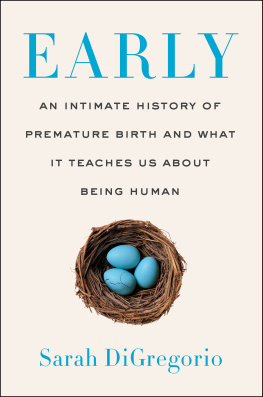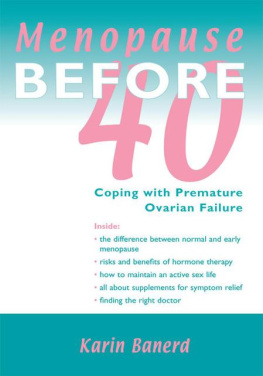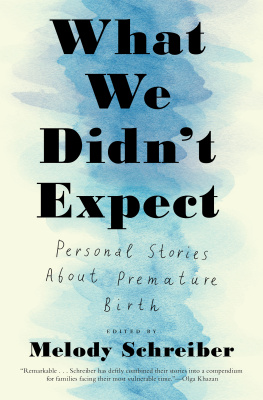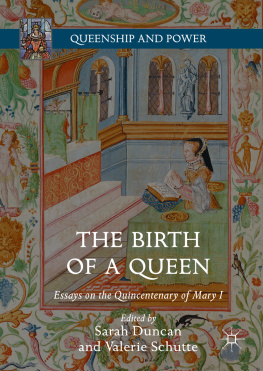Sarah DiGregorio - Early: An Intimate History of Premature Birth and What It Teaches Us About Being Human
Here you can read online Sarah DiGregorio - Early: An Intimate History of Premature Birth and What It Teaches Us About Being Human full text of the book (entire story) in english for free. Download pdf and epub, get meaning, cover and reviews about this ebook. year: 2019, publisher: HarperCollins, genre: Art. Description of the work, (preface) as well as reviews are available. Best literature library LitArk.com created for fans of good reading and offers a wide selection of genres:
Romance novel
Science fiction
Adventure
Detective
Science
History
Home and family
Prose
Art
Politics
Computer
Non-fiction
Religion
Business
Children
Humor
Choose a favorite category and find really read worthwhile books. Enjoy immersion in the world of imagination, feel the emotions of the characters or learn something new for yourself, make an fascinating discovery.
- Book:Early: An Intimate History of Premature Birth and What It Teaches Us About Being Human
- Author:
- Publisher:HarperCollins
- Genre:
- Year:2019
- Rating:3 / 5
- Favourites:Add to favourites
- Your mark:
- 60
- 1
- 2
- 3
- 4
- 5
Early: An Intimate History of Premature Birth and What It Teaches Us About Being Human: summary, description and annotation
We offer to read an annotation, description, summary or preface (depends on what the author of the book "Early: An Intimate History of Premature Birth and What It Teaches Us About Being Human" wrote himself). If you haven't found the necessary information about the book — write in the comments, we will try to find it.
Sarah DiGregorio: author's other books
Who wrote Early: An Intimate History of Premature Birth and What It Teaches Us About Being Human? Find out the surname, the name of the author of the book and a list of all author's works by series.
Early: An Intimate History of Premature Birth and What It Teaches Us About Being Human — read online for free the complete book (whole text) full work
Below is the text of the book, divided by pages. System saving the place of the last page read, allows you to conveniently read the book "Early: An Intimate History of Premature Birth and What It Teaches Us About Being Human" online for free, without having to search again every time where you left off. Put a bookmark, and you can go to the page where you finished reading at any time.
Font size:
Interval:
Bookmark:
For Phyllis and Mira, my mother and my daughter,
who taught me how to be brave.
And with gratitude to the nurses, physicians,
and thinkers who were our partners in gestation.
Throughout this book, for flow and simplicity, I refer to preterm babies as preterm, premature, or, more casually, preemies. The current medical term is preterm, not premature, but, since they are both commonly used in the vernacular, I use them both.
In some cases I refer to a fetus as a baby, because that is how some people think of their fetuses, especially as the pregnancy progresses. In some instances, I have used it to accurately describe the way parents thought of their pregnancies.
In places, there are references to pregnant women instead of pregnant people, which might be read as conflating womanhood and the biological capacity for pregnancy, which is not always the case. Trans men and nonbinary people can also get pregnant and experience everything that pregnancy might entail, and I hope people of all genders will feel included by this book.
If theres one thing I have learned, its that good physicians do not always agree; in fact, they more often disagree. The scientific and medical information in this book is as accurate as possible at the time of this writingit changes all the timebut it is not comprehensive. I have not covered every possible iteration of preterm birth, nor is this a book to turn to for medical advice. If you are in need of medical advice, the very best thing you can do is ask your clinician, who knows your child, who is unique in the world. Show up with a notebook and a pen, and dont be afraid to keep asking questions until you understand.
One name has been changed, and several last names omitted, to protect privacy. Some details have been omitted for the same reason. But nothing inaccurate has been added. Interviews have been condensed and edited for clarity.
Finally, there are parts of this book that might not be comfortable for pregnant people to read. There are parts that might be hard on parents whose babies are still in the neonatal intensive care unit (NICU). Its true that giving birth prematurely is frightening and there can be long-term health implications. But the larger, overarching truth is this: The vast majority of babies born prematurely go on to live happy, healthy lives. No one wants to see their child face challenges. But the better information and support you have, the easier everything will be.
The NICU [is] a strong, strange, powerful place.
There is probably no eerier place in a hospital than the NICU. One enters thinking that one is prepared to see tiny babies. But the babies are unimaginably tiny. They are magical.... The babies seem almost, but not quite, human, almost, but not quite, fetal. In their chimerical, half-human, half-machine state they seem not only helpless and pitiful but also exotic, threatening, futuristic, feral, untamed, barbarous...
[And yet these] are just babies.... They are real little people, and this spaceship, this high-tech roller coaster, this cyberwomb, is their introduction to life on earth.
DR. JOHN D. LANTOS, THE LAZARUS CASE: LIFE-AND-DEATH ISSUES IN NEONATAL INTENSIVE CARE
THIS ISNT THE story of one birth; its the story of millions of births. But, for me, it started with Mira.
The first time I saw my daughter she was wrapped in a pink-and-blue-striped hospital blanket, the same one that bundles every infant in every photo on Facebook. She was briefly held aloft for me to see by a nurse who was hustling her out of the operating room. My memory of the moment is unreliable. I know she was intubated, but I dont remember the tube down her throat, as though some kind censor in my mind has blacked it out. I cant remember anything about the way she looked, only the impossible, science-fiction smallness of her, a 1-pound, 13-ounce baby, the blur of scrubs in motion, and the way my husbands face crumpled like a piece of paper at the sight of her, the way his head fell into his hands. Separated from my numbed bottom half by a hanging blue sheet, I felt weirdly calm, set apart from the proceedings. I had only one thought, like a beat: Shes alive. Shes alive. Shes still alive.
My body had been trying to kill her. Months earlier we were sitting in a young radiologists office when she pushed a printout of blood work results across the lacquered desk to us. Theres a small chance, maybe a 1 percent chance, that shell be a little early, a little small, said the doctor, pointing to one line on the sheet. She had just completed our twelve-week ultrasound and blood work, and everything was fine except for one abnormality: very low PAPP-Athe jaunty nickname for pregnancy-associated plasma protein A. The lack of it suggested a subpar placenta, the organ responsible for delivering nutrients and oxygen to a baby in the womb. My (our?) level of this protein was in the second percentile. After twenty-four weeks, well have you come in for growth scans to make sure she stays on her growth curve, said the radiologist. But its nothing to worry about. Nothing to worry about; nothing to worry about. The refrain of my pregnancy.
Of course, I went back to my office and looked it up. Like the extremely responsible Googler that I am, I skipped the many results for pregnancy message-board threads with subject lines like Low PAPP-A, how worried should I be????? and went straight for the scientific literature, all of which went something like this:... associated with stillbirth, infant death, intrauterine growth restriction, preterm birth, and preeclampsia. It was all associations, not causations: nothing certain, but nothing good.
I went outside to escape my cubicle. I stood in the middle of the sidewalk, buffeted by bodies. In midtown Manhattan, theres nowhere good to cry, so I balanced on a fire hydrant and sobbed. Two months earlier I had had a miscarriage at ten weeks and a painful dilation-and-extraction procedure to remove the dead fetus from my uterus, which seemed inclined to not give up. I sat up from the stirrups, noticed that my socks were splattered with a horror movies worth of blood, and started to understand in a bone-deep way that having a child was not going to be easy. I couldnt imagine losing another one. But then, no one can.
At my next obstetrician appointment, my preferred OB, Dr. M., was away. The doctor covering for her wanted to talk about our risk for Down syndrome. It was odd, because although that blood serum test, the one that indicated low PAPP-A, can be used to assess a risk of a chromosomal abnormalities, I had also had a fetal DNA test, which identifies conditions like Down syndrome with better accuracy. The DNA had come back normalNormal female, to be exact. (I was surprised how blissed out I was at the news that the baby was a girl.) Nevertheless, the doctor went over the fact that low PAPP-A is associated with chromosomal problems, even though, as far as I could tell, we knew that outcome wasnt at all likely. I opted not to have an amniocentesis, which would have definitively ruled out a chromosomal syndrome, but which also carries a small risk of miscarriage. As for the other worriesthe intrauterine growth restriction (IUGR), the preterm birth, stillbirthI wasnt able to extract any meaningful information. Ive had lots of patients with low PAPP-A who went on to have healthy, full-term babies, the doctor said. Were going to monitor growth after twenty-four weeks. Try not to worry.
SHE MEANT IT. It was only one ominous test result, and there was no other indication that anything was amiss. But what I didnt know then was that when doctors kept saying, Dont worry, they really meant two things: One, there probably really was nothing to worry about. Two, there was no point in worrying, because there was no treatment, no preventative, for what might happen. For what was about to happen. Not worrying was the best we could do. But I couldnt manage it.
Font size:
Interval:
Bookmark:
Similar books «Early: An Intimate History of Premature Birth and What It Teaches Us About Being Human»
Look at similar books to Early: An Intimate History of Premature Birth and What It Teaches Us About Being Human. We have selected literature similar in name and meaning in the hope of providing readers with more options to find new, interesting, not yet read works.
Discussion, reviews of the book Early: An Intimate History of Premature Birth and What It Teaches Us About Being Human and just readers' own opinions. Leave your comments, write what you think about the work, its meaning or the main characters. Specify what exactly you liked and what you didn't like, and why you think so.






